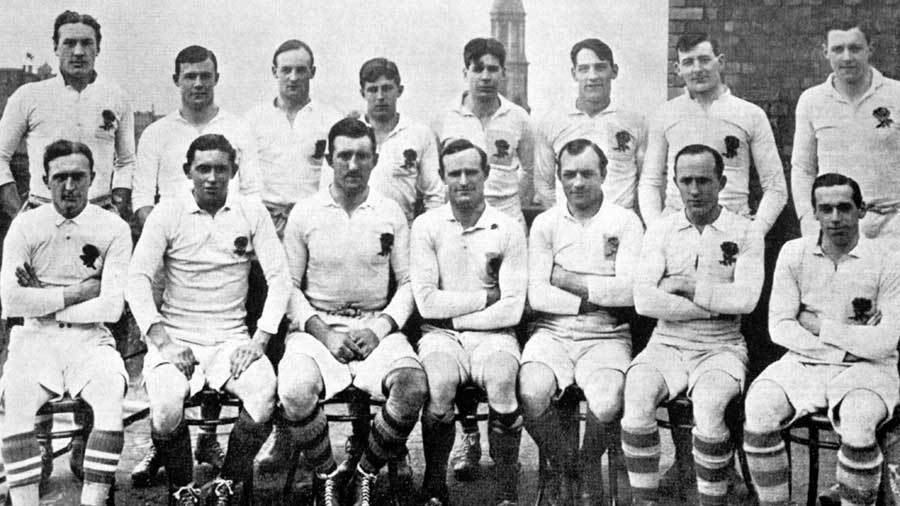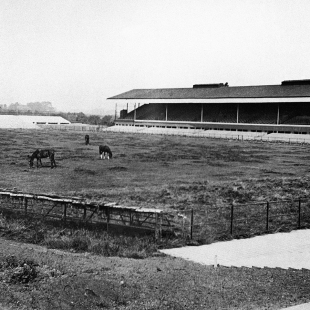|
First World War Centenary
From rugby field to trench warfare
Huw Richards
August 4, 2014

The England team pose for a group photo in 1914 © PA Photos
Enlarge
If there were any doubts or misgivings in the world of rugby 100 years ago this month as the First World War broke out, they were very well concealed. The Rugby Football Union and other national governing bodies rapidly decreed a closedown after Britain's declaration of war on August 4, with the Scots offering Inverleith - Murrayfield's predecessor - for military use. New Zealand and Australia played to the end of their season - fitting in a couple of Test matches - before closing down and contributing their share to the slaughter in Europe. Even had the unions wished to carry on, it is doubtful there would have been enough players available by the scheduled start of the 1914/15 season. As Walter Carey, Bishop of Bloemfontein and former British Lion, was to write in 1921: "Good old rugby football. All over the British Isles its exponents were in the van of those who went." When EHD Sewell came to chronicle the lives of the horrifyingly long list of internationals from Britain killed in the war, he pointed that out that all had been volunteers and none conscripts. Where they had not joined up at the earliest possible opportunity, Sewell was at pains to establish and explain reasons - such as illness or being abroad. 
Horses graze on the playing field at an empty Twickenham in the summer of 1915
© PA
Enlarge
The First World War was an unusually democratic conflict, in that officers were in as much peril as the other ranks. Trench warfare, which periodically sent men over the top in doomed assaults on machine-gun toting adversaries, might have been designed specifically as a means of killing rugby players. The usual leaders of those attacks were junior officers - young, vigorous middle and upper class men, the game's dominant demographic. The game they left behind, and to which so many were not to return, was still a comparatively new one. Its earliest days as an organised sport were well within living memory. It was only 43 years - the same length of time which separates us from the exploits in New Zealand of Carwyn James and John Dawes' victorious British Lions - since the formation of the RFU, the first authoritative set of rules and the first international match. Since those had all been the achievements of young men, many pioneers were still around. Neither Leonard Maton, who had been deputed to draw up the first set of rules while confined to bed with a broken leg, nor England's first captain Frederick Stokes had yet reached the qualifying age of 70 set when old-age pensions had been instituted six years earlier. Lacking elders, the early game had elevated recent or even current players into positions of administrative authority. So it was that the game had rulers who were already veterans in their roles, yet still only middle-aged. Horace Lyne, president of the Welsh Rugby Union, had represented the WRU on the International Rugby Board since its formation in 1887, but was still only 53. He and Walter Rees, two years younger and WRU secretary since 1896, would still be in place at the end not only of the war that broke out in August 1914 but of the one which followed in September 1939. Many of the game's momentous early developments were still fresh in their minds. Lyne had played in a Wales team which lined up nine forwards and three three-quarters, rather than the eight and four which became standard practice. The schism with northern union, as rugby league was still known, was less than 20 years old. International rugby had taken on a fresh dimension in the past decade with the first visits - in the space of four Edwardian seasons - by the All Blacks, South Africa and Australia. Yet the greatest rivalry of all, New Zealand v South Africa, would not be born until 1921. 
Wales' Dickie Owen once held the record for the most number of international caps - 35
© PA
Enlarge
The Four home nations were only recently become Five with France, admitted by stages between 1906 and 1910, still to earn respect as serious opposition. In five full seasons they had won exactly as many matches - one, against Scotland in 1911 - as their supporters had contrived minor riots, at the same fixture in 1913, leading to its cancellation in the year war broke out. France's admission gave players the chance to win four caps in a season rather than the previous three. The option had not greatly impressed the reigning all-time record holder, Dickie Owen of Wales. The first great specialist scrum-half, Owen had won 35 caps between 1901 and 1912. There should have been a 36th, but in his final year he preferred to go with Swansea on a tour of Devon rather than play against France. Nor was his choice down to an aversion to travelling. The international was played at Rodney Parade, Newport. Owen typified a record book which, when the lights went out across Europe in August 1914, had a distinctly Welsh accent. He had taken the caps record from his Swansea club-mate Billy Bancroft, still second on the list with 33. And the all time points-scoring list was led by yet another All White, Billy's younger brother Jack - both were fullbacks - who had scored 88 points. Jack's closest pursuer was the Irishman Dicky Lloyd whose 63 points included 24 from a record six drop-goals, still worth four points to three for a try or penalty. Ireland, establishing a tradition of durability which has lasted to this day, also had the two players other than Owen and Jack Bancroft with more than 30 caps - centre Louis Magee (given names Aloysius Mary), whose tally included Lions appearances, and forward George Hamlet. Seven of the 10 most capped players were Welsh and their monopoly of the top try-scorers was even more complete - the first six places occupied by Willie Llewellyn (20), Reggie Gibbs (20), Johnny Williams (17), Teddy Morgan (15), Rhys Gabe (12) and Billy Trew (11). The leading non-Welshmen were Jack Birkett - whose 21 caps were also an England record, son of Reg, who played in the first ever international, and New Zealander Frank Mitchinson, both with 10. Owen, unsurprisingly had played in most winning test teams (27), while the champion loser was the most-capped Frenchman Marcel Communeau, defeated in 20 out of 21 appearances, but with the supreme consolation of having been captain on the odd day out, the defeat of the Scots in 1911. England had won all four matches in both 1913 and 1914 - emulating Wales's consecutive clean sweeps of 1908 and 1909. But nobody talked of Grand Slams or would do so until the term was first used by the Times in 1957. It was competition between the founding quartet which still mattered.
Wales and England had dominated in recent years, but this had simply served to bring their historical record up alongside Scotland. The Scots had led on Triple Crowns until 1907, since when Wales' three in four years between 1908 and 1911 had given them a seven to five lead. England's ninth championship, counting shared titles, in 1914 brought them alongside Scotland. It had taken a miserable season in 1914, losing to their home rivals and refusing to play the French, to knock Scotland off the top of the all-time table, reducing their overall winning percentage from 60.22 to 58.33 and enabling Wales (59.13) to squeeze past them. It is tempting to diagnose the roots of Scotland's later decline in the exceptional destruction, 30 deaths, wrought on their international players over the next four years. But the decade after the war was to be one of Scotland's best of the 20th century and they were still second on all-time record at the end of the 1930s. If there is a straw in the wind it is to be found in the all-time playing records of the main nations, in which New Zealand, with 18 wins from 23 matches, already had a clear lead in winning percentage. If All Black tours had been one major New Zealand innovation of the previous decade, the other had been the introduction of the Ranfurly Shield for provincial teams, held at the outbreak of war by Taranaki, which would lose to Wellington in September 1914. In South Africa the Currie Cup had been won, for the ninth time in 11 tournaments, by Western Province. Competition, at least for clubs, was frowned upon in much of Britain. But Scotland and Wales both had sufficiently tight-knit club setups for hierarchies to be reasonably clear and for newspapers to calculate unofficial league tables. Watsonians were reckoned the best team in Scotland, as they had been for much of the decade, but Pontypool struck a blow in 1914 for Wales' smaller clubs by taking their first unofficial title.
Ireland did have competition, on a provincial basis, and established orders tended to prevail. Dublin University won their 17th Leinster Cup in 32 seasons, while Garryowen's Munster Cup was their 17th in 26 and the Cork duo of University College and Constitution shared the Munster League title. Sligo Town were first-time winners in Connacht while Ulster had no champions, the local political situation tense enough to lead to the suspension of competition. It is hard to assess which was England's best club. Blackheath had five players in the last England team before the war, which contained only one - from Gloucester - from a club in the 2014 Premiership. Leicester formed the foundation of a Midlands team which won the County Championship in a final with a strong end-of-era feel. It was the Midlands' only title before progressive fragmentation into a number of unions while losers Durham were playing their 11th final since 1900, but would appear only once more in the next half-century. London Hospital, fielding Bill Stewart, a Tasmanian-born wing whose seven tries for Scotland in 1913 were the championship record (and still rank second 101 years later), won their fourth Hospitals Cup in a decade, but their last until the 1950s. France's champions, for the first time, were Perpignan, a title claimed a century to the day before relegation from the Top 14 earlier this year. France also saw both the last birth of an international rugby player before, and the first after, the outbreak of hostilities. Each was to have a career, as well as his birth, defined by war. Born on July 31, 1914, Robert Tourte's single cap would be won in the French team which played its last test before the collapse of 1940, the 36-3 defeat by the British Army in February of that year. And Andre Sahuc (born August 4) had to wait until he was 30 to win his two caps, also against British forces teams in 1945. If the slaughter of the western front makes the early 1890s the least propitious years of birth for international rugby players, their experience shows that 1914 was to be pretty unpromising as well. © ESPN Sports Media Ltd
| ||||||||||||||||||||||||||||||
Live Sports
Communication error please reload the page.
-
Football
-
Cricket
-
Rugby
-
- Days
- Hrs
- Mins
- Secs
F1 - Abu Dhabi GP
Abu Dhabi Grand Prix December 11-131. Max Verstappen ()
2. Valtteri Bottas (Mercedes)
3. Lewis Hamilton (Mercedes)
4. Alexander Albon ()
5. Lando Norris ()
6. Carlos Sainz Jr ()
-
ESPNOtherLive >>
Golf - Houston Open
Snooker - China Open
Tennis - Miami Open

